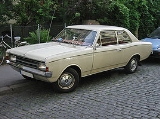
Opel Rekord
Encyclopedia
The Opel Rekord was a large family car
/executive car
which was built in several generations by the German car manufacturer
Opel
.
name, which pre-dated the Rekord but was also re-instated in a separate model in 1967.
The various generations are described here with the manufacturer's, or other commonly used designations such as "Rekord P I" or "Rekord B". The car was not marketed with these additional appellations.
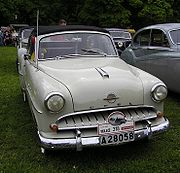
 The Opel Olympia Rekord was introduced in March 1953 as successor to the Opel Olympia, a pre-World War II design dating back to 1935. The Opel Olympia Rekord was built until 1957 in four different versions. Around 580,000 units were produced.
The Opel Olympia Rekord was introduced in March 1953 as successor to the Opel Olympia, a pre-World War II design dating back to 1935. The Opel Olympia Rekord was built until 1957 in four different versions. Around 580,000 units were produced.
General data:
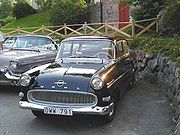
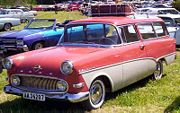 The Opel Rekord P I had a slightly larger, more modern body with wraparound windscreen and rear screen, introducing to Germany the latest American fashion of two-tone paintwork.
The Opel Rekord P I had a slightly larger, more modern body with wraparound windscreen and rear screen, introducing to Germany the latest American fashion of two-tone paintwork.
The standard model was sold as the Opel Olympia Rekord, while a reduced specification version was marketed simply as the Opel Olympia and widely known, less formally, as the "Bauern-Buick" (Peasant's Buick).
A new base version with an 1196 cc engine appeared in 1959 badged more simply as the Opel 1200, and replacing the Opel Olympia.
A semi-automatic gearbox ("Olymat") became available for model year 1959. Initially the car retained the 1488 cc, 45 hp (DIN) of its predecessor: this was complemented by a 1680 cc, 55 hp (DIN);L engine for model year 1960.
The PI remained in production until 1960.
Price in Germany: DM 6,545 to 7,110. 307,000 units (P I) + 67.952 units (1200). In 1959–60, Autenrieth of Darmstadt
, Germany converted P I two-door sedans to coupé
s and cabriolets, in very limited numbers. Prices were DM 9,380 for the coupé and DM 11,180 for the convertible.
General data:
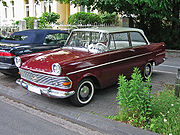
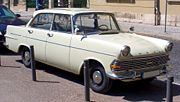 The Rekord P II grew in size, if not in wheelbase, and received a totally new body that did away with wraparound windows. It was available in several body versions: 2-door and 4-door saloon, a 3-door estate ("Caravan") plus delivery van, a pick-up
The Rekord P II grew in size, if not in wheelbase, and received a totally new body that did away with wraparound windows. It was available in several body versions: 2-door and 4-door saloon, a 3-door estate ("Caravan") plus delivery van, a pick-up
, and a convertible. From August 1961 on, a works coupé became available, and in June 1962 a more luxurious "L" version was added with a new top engine of 1700 cc "S" and a higher compression ratio. The latest versions had an optional four-speed gearbox.
Prices in Germany: DM 6,545 to 7,770. 787,684 units made. Autenrieth continued to sell a handful of convertibles at DM 11,635.
General data:

 The Rekord A line-up was a repeat of the Rekord P II (two- and four-door saloon, two-door estate and delivery van, two-door coupé with 1500 or 1700 or 1700 S engines), but the bodies were completely new and the wheelbase stretched to 103.3 inches (2,623.8 mm). March 1964 saw the introduction of the Rekord L-6 with the Opel Kapitän's 2.6 litre inline-six.
The Rekord A line-up was a repeat of the Rekord P II (two- and four-door saloon, two-door estate and delivery van, two-door coupé with 1500 or 1700 or 1700 S engines), but the bodies were completely new and the wheelbase stretched to 103.3 inches (2,623.8 mm). March 1964 saw the introduction of the Rekord L-6 with the Opel Kapitän's 2.6 litre inline-six.
Prices in Germany: DM 6.830 to 9.370; front disc brakes: + DM 200, four-speed with floor shift: + DM 180. 885,292 units. In very limited numbers, Karl Deutsch
of Cologne
sold a convertible version with either 1700 S or 2600 engine at DM 11,765 and 13,060 respectively.
General data:
. The 2600 cc six-cylinder engine remained unchanged. The line-up was identical to the Rekord A.
Prices in Germany: DM 6,980 to 9,570; power brakes: + DM 95, automatic gearbox: + 950, four speed gearbox: + 95. 296,771 units.
General data:
.
The range consisted of the two- and four-door saloon, two- and (new) four-door estate, delivery van, and two-door hardtop coupé with 1500, 1700, 1700 S, 1900 S fours or (until 1968) a 2200 six. Very short-lived (1967 only) was a special taxi version on a longer wheelbase (113 inch) with division, that sold for DM 9,950; with it, Opel tried to get a foothold in the German taxi market, then (as now) dominated by Mercedes-Benz
. Again, Karl Deutsch of Cologne offered a convertible version in limited numbers.
There existed several variations of the Rekord C, as well as version made under different names in different countries.
A variation on the Rekord C was the Rekord Sprint coupé (1967–71) with driving lights, sport steel wheels, sport stripes and a sporty interior; the Sprint received exclusively the so-called 1900 H engine with two double-barrel carburettors, good for 106 hp (DIN) and 108 mi/h.
The former Rekord L-6 was replaced by the new Commodore
A, a slightly disguised and better-equipped Rekord C available as two- and four-door sedan and hardtop coupé with six cylinder engines only.
It was during the life of this model (in fact 1967–70) that the Opel Olympia
name was revived, but in a separate, smaller car which was based on the period Opel Kadett
.
Due to the launch of the smaller Ascona
in September 1970, the Rekord was marketed as an executive car
rather than a large family car
.
FD range of the time. Initially, there were two models: Ranger 130 and Ranger 153. In 1970 additional models were announced, being the Ranger 1900 and Ranger 2500, and a "SS" variant, based on the Ranger 153.
There was also a South Africa
n Ranger, built in General Motors South Africa
's plant Port Elizabeth. Known as 'South Africa's Own Car', it featured a springbok logo on its grille, and was also produced as a station wagon
.
Opala
and Comodoro in Brazil
from 1968 on, available in saloon, coupé and estate forms and featuring either Chevrolet's 2.5 L four or 4.1 L inline-six. These models received several facelifts and remained in production until about 1992.
A Rekord C coupé was locally-built in South Africa as a Chevrolet SS during the 1970s.
Prices in Germany (1966): DM 7,630 to 9,560; Sprint (1967): DM 9,775.
The Rekord C was the only Opel model to ever be marketed in Mexico as Opel; Corsa
, Astra
and others were sold under Chevrolet during the 1990s and first decade of the 21st century.
General data:
The Rangers were also transferred to this new generation, with the dropping of the 130 and 153 and the adding of a 1.7 L engine. In 1972, the line-up consisted of the base Ranger 1700, the mid-level Ranger 1900, and the top-of-the-line Ranger 2500. In 1974, a 2.8L engine was introduced to the Ranger family. However, by that time the Rangers were unpopular, and were discontinued after the 1976 model year. Most of these were sold exclusively in Continental Europe, especially the Benelux
region.
South Africa used this body type for their Chevrolet 2500, 3800 and 4100 series. They looked visually almost identical but had the Chevrolet 2500 (4 cylinder) or 3800 and 4100 (6 cylinder) engines installed. They were available as four door saloon or estate. The six cylinder versions could be differentiated from the "fours" as they had four round headlights as opposed to the two rectangular units.
These cars were also assembled in Iran (before revolution) from 1974 till 1977 under the local "Chevrolet Royale / or Chevrolet Iran" brand-name by Iran General Motors
. The two models were 2500 and 2800 with 2.5L and 2.8L, respectively.The production of these vehicles ended in 1977 when the assembly line started producing the Chvrolet Nova, Buick Skylark, and Cadillac Seville cars until 1987.
). In some markets where the tax structure was suitable, a three-door van version was also available.
A version of the EI was sold by Vauxhall
in the United Kingdom from 1979 as the Carlton
, which featured the distinct slanted front end shared with the Chevette
and Cavalier
. The Carlton quietly succeeded the (by then long since discontinued) Vauxhall Victor FE
, and was joined by the short lived Vauxhall Viceroy, a rebadged Commodore C
. In the UK both models were outsold by the Ford Granada
.
After the release of the E2 in 1982, Vauxhall Carltons were distinguishable from Opel Rekords only by their badging, with no sheet metal changes. Models sold in the UK had 2.0 L petrol and 2.3 L diesel engines in base, Berlina and Berlina S trim levels, and were all available with either a four-speed manual or a three-speed automatic transmission. In mainland Europe a host of different engines were available, ranging from a 1.7 L to a 2.2 L petrol and also including a 2.0 L diesel for countries such as Italy, where larger engines were heavily taxed. The diesel engines were taller and necessitated a distinctive bonnet with a large hump in it. Diesel Rekords were particularly popular in France, Italy, and the Benelux
countries.
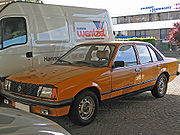 The Rekord EI was the basis of the original 1978 Holden VB Commodore. However, to cope with Australian conditions it was strengthened substantially and used the Senator's nose (like the Opel Commodore
The Rekord EI was the basis of the original 1978 Holden VB Commodore. However, to cope with Australian conditions it was strengthened substantially and used the Senator's nose (like the Opel Commodore
) to accommodate the Holden straight-6 and V8 engines.
In South Africa the model was sold as a Chevrolet
until 1982, when it was rebadged as an Opel. South African Rekords originally received a small bore version of GM's venerable Iron Duke
four-cylinder engine, of 2,320 cc and 90 PS at 4,800 rpm. The facelifted EII versions received the 1,979 cc four as used in Europe, with 100 PS (110 PS for the fuel injected version). Delta Motor Corporation, which bought out GM's South African subsidiary after it divested from the country in 1986, produced the EII model until the early 1990s. Later South African Rekords featured the Opel badge above the grille, similar to the smaller Kadett.
A version of the Rekord, known as the Royale
, was produced by Daewoo
in South Korea
, featuring the front end of the larger Senator
. This should not be confused with the Vauxhall Royale, which was effectively a rebadged Opel Monza/Opel Senator. Bodies for the Daewoo came from Holden in Australia.
UK Models
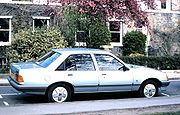
Large family car
A large family car, also known as a D-segment car, is a European automobile classification which is larger than a small family car and smaller than an executive car. Multi-purpose vehicles based on a large family car design are often called large MPVs, while similarly-priced models from luxury car...
/executive car
Executive car
Executive car is a British term that refers to a car's size and is used to describe an automobile larger than a large family car. In official use, the term is adopted by EuroNCAP, a European organisation founded to test car safety.- History :...
which was built in several generations by the German car manufacturer
Automaker
The automotive industry designs, develops, manufactures, markets, and sells motor vehicles, and is one of the world's most important economic sectors by revenue....
Opel
Opel
Adam Opel AG, generally shortened to Opel, is a German automobile company founded by Adam Opel in 1862. Opel has been building automobiles since 1899, and became an Aktiengesellschaft in 1929...
.
Naming
The Rekord name evolved into the main name of the model; at first the name was used in close relationship with the Opel OlympiaOpel Olympia
The Opel Olympia is a small family car produced by the German automaker Opel from 1935 to 1940, from 1947 to 1953 and again from 1967 to 1970.The 1935 Olympia was Germany's first mass-produced car with an all-steel unitized body . This revolutionary technology reduced the weight of the car by 180...
name, which pre-dated the Rekord but was also re-instated in a separate model in 1967.
The various generations are described here with the manufacturer's, or other commonly used designations such as "Rekord P I" or "Rekord B". The car was not marketed with these additional appellations.
Opel Olympia Rekord (1953–57)


- 1953/54: 1488 cc, 40 hp (DINDeutsches Institut für Normungis the German national organization for standardization and is that country's ISO member body. DIN is a Registered German Association headquartered in Berlin...
). Available as two-door saloon, cabriolet and estateStation wagonA station wagon is a body style variant of a sedan/saloon with its roof extended rearward over a shared passenger/cargo volume with access at the back via a third or fifth door , instead of a trunk lid...
(Caravan). Price in Germany: DM 6,410 to 6,710. 136,028 units made.
- 1955: 1488 cc, 40 hp (DIN). Mild facelift, comprising larger rear window, new grill insert. New base model called simply OlympiaOpel OlympiaThe Opel Olympia is a small family car produced by the German automaker Opel from 1935 to 1940, from 1947 to 1953 and again from 1967 to 1970.The 1935 Olympia was Germany's first mass-produced car with an all-steel unitized body . This revolutionary technology reduced the weight of the car by 180...
; a vanVanA van is a kind of vehicle used for transporting goods or groups of people.In British English usage, it can be either specially designed or based on a saloon or sedan car, the latter type often including derivatives with open backs...
based on the saloon introduced as the "delivery" variant. Price in Germany: DM 5,850 to 6,710. 131,586 units made.
- 1956: 1488 cc, 45 hp (DIN). New grill insert, bumpers now without guards. Price in Germany: DM 5,410 to 6,560. 144,587 units made.
- 1957: 1488 cc, 45 hp (DIN). New grill insert again, flatter roof, chrome strips along belt line. The cabriolet was no longer part of the line. Prices in Germany: DM 5,510 to 6,560. 169,721 units made.
General data:
- Wheelbase 97.9 in (2,487 mm)
- Length 166.9 in (4,239 mm)
- Width 64 in (1,626 mm)
- Height 61 in (1,549 mm)
- Kerb weight 2020 lb (916.3 kg)-2200 lb (997.9 kg)
- Top speed approximately 75 mi/h
Opel Rekord P I (July 1957 – July 1960)


The standard model was sold as the Opel Olympia Rekord, while a reduced specification version was marketed simply as the Opel Olympia and widely known, less formally, as the "Bauern-Buick" (Peasant's Buick).
A new base version with an 1196 cc engine appeared in 1959 badged more simply as the Opel 1200, and replacing the Opel Olympia.
A semi-automatic gearbox ("Olymat") became available for model year 1959. Initially the car retained the 1488 cc, 45 hp (DIN) of its predecessor: this was complemented by a 1680 cc, 55 hp (DIN);L engine for model year 1960.
The PI remained in production until 1960.
- 1958–59: 1488 cc, 45 hp (DIN). Available as two-door "Olympia" base model or more luxurious two-door "Olympia Rekord" and as three-door estate ("Caravan") and "delivery" van based on the saloon. Price in Germany: DM 5,785 to 6,845. 509,110 units were made.
- 1959: 1488 cc, 45 hp (DIN); on request 1680 cc, 55 hp (DIN). Also available as four-door saloon. Several refinements including padded dashboard, ignition lock, electrically driven windscreen wipers. The new base model "Opel 1200" replaced the former OlympiaOpel OlympiaThe Opel Olympia is a small family car produced by the German automaker Opel from 1935 to 1940, from 1947 to 1953 and again from 1967 to 1970.The 1935 Olympia was Germany's first mass-produced car with an all-steel unitized body . This revolutionary technology reduced the weight of the car by 180...
(1196 cc, 40 hp (DIN), DM 5,835); the 1200 remained in production until December 1962, while the P I was superseded in August 1960 by the Rekord P II.
Price in Germany: DM 6,545 to 7,110. 307,000 units (P I) + 67.952 units (1200). In 1959–60, Autenrieth of Darmstadt
Darmstadt
Darmstadt is a city in the Bundesland of Hesse in Germany, located in the southern part of the Rhine Main Area.The sandy soils in the Darmstadt area, ill-suited for agriculture in times before industrial fertilisation, prevented any larger settlement from developing, until the city became the seat...
, Germany converted P I two-door sedans to coupé
Coupé
A coupé or coupe is a closed car body style , the precise definition of which varies from manufacturer to manufacturer, and over time...
s and cabriolets, in very limited numbers. Prices were DM 9,380 for the coupé and DM 11,180 for the convertible.
General data:
- Wheelbase 100 in (2,540 mm)
- Length 174.9 in (4,442 mm)
- Width 63.6 in (1,615 mm)
- Height 58.7 in (1,491 mm)
- Kerb weight 2010 lb (911.7 kg)-2210 lb (1,002.4 kg)
- Top speed 74 mi/h–82 mi/h.
Opel Rekord P II (1960–63)


Pickup truck
A pickup truck is a light motor vehicle with an open-top rear cargo area .-Definition:...
, and a convertible. From August 1961 on, a works coupé became available, and in June 1962 a more luxurious "L" version was added with a new top engine of 1700 cc "S" and a higher compression ratio. The latest versions had an optional four-speed gearbox.
Prices in Germany: DM 6,545 to 7,770. 787,684 units made. Autenrieth continued to sell a handful of convertibles at DM 11,635.
General data:
- Engines: 1488 cc, 50 hp (DIN), or 1680 cc, 55 hp (DIN) or 1680 cc, 60 hp (DIN)
- Wheelbase 100 in (2,540 mm)
- Length 177.8 in (4,516 mm)
- Width 64.3 in (1,633 mm)
- Height 58.6 in (1,488 mm)
- Kerb weight 2075 lb (941.2 kg)-2240 lb (1,016 kg)
- Top speed 77 mi/h-87 mi/h
Opel Rekord A (1963–65)


Prices in Germany: DM 6.830 to 9.370; front disc brakes: + DM 200, four-speed with floor shift: + DM 180. 885,292 units. In very limited numbers, Karl Deutsch
Karl Deutsch
Karl Wolfgang Deutsch was a Czech social and political scientist from a German speaking family. His work focused on the study of war and peace, nationalism, co-operation and communication...
of Cologne
Cologne
Cologne is Germany's fourth-largest city , and is the largest city both in the Germany Federal State of North Rhine-Westphalia and within the Rhine-Ruhr Metropolitan Area, one of the major European metropolitan areas with more than ten million inhabitants.Cologne is located on both sides of the...
sold a convertible version with either 1700 S or 2600 engine at DM 11,765 and 13,060 respectively.
General data:
- Engines: 1488 cc, 55 hp (DIN), or 1680 cc, 60 or 67 hp (DIN), or 2605 cc, 100 hp (DIN)
- Wheelbase 103.9 in (2,639 mm)
- Length 178 in (4,521 mm)
- Width 66.8 in (1,697 mm)
- Height 57.7 in (1,466 mm)
- Kerb weight 2140 lb (970.7 kg)-2510 lb (1,138.5 kg)
- Top speed 81 mi/h-104 mi/h
Opel Rekord B (1966–67)
While the Rekord B consisted of only a mild facelift compared to the A, it received Opel's new, more oversquare four cylinder CIH (cam in head) engines (1500, 1700 S, 1900 S). The CIH engines were used in all subsequent Rekord generations until 1986, when Rekord was replaced by the Opel OmegaOpel Omega
The Opel Omega was an executive car marketed by the German automaker Opel between 1986 and 2003 in two generations, both manufactured at Opel's Rüsselsheim, Germany plant. The first generation, the Omega A , superseded the Opel Rekord, was voted European Car of the Year for 1987, and was available...
. The 2600 cc six-cylinder engine remained unchanged. The line-up was identical to the Rekord A.
Prices in Germany: DM 6,980 to 9,570; power brakes: + DM 95, automatic gearbox: + 950, four speed gearbox: + 95. 296,771 units.
General data:
- Engines: 1492 cc, 60 hp (DIN), or 1698 cc, 75 hp (DIN), or 1897 cc, 90 hp (DIN), or 2605 cc, 100 hp (DIN)
- Wheelbase 103.9 in (2,639 mm)
- Length 178.3 in (4,529 mm)
- Width 66.6 in (1,692 mm)
- Height 56.7 in (1,440 mm)
- Kerb weight from 2190 lb (993.4 kg)
- Top speed 83 mi/h-104 mi/h
Opel Rekord C (1967–71)
With 1,276,681 units built, the Rekord C was the most successful Rekord so far. The car proved to be a solid hit with the public: it was reliable, roomy and pleasant to look at with its coke-bottle lineCoke bottle styling
Coke bottle styling is a term used to describe any automotive body styling bearing an overall body shape resembling the classic glass Coca-Cola soft drink's contour bottle design. It is a style of automobile bodies with outward curving fenders with a narrow center. In contrast to "straight-edge"...
.
The range consisted of the two- and four-door saloon, two- and (new) four-door estate, delivery van, and two-door hardtop coupé with 1500, 1700, 1700 S, 1900 S fours or (until 1968) a 2200 six. Very short-lived (1967 only) was a special taxi version on a longer wheelbase (113 inch) with division, that sold for DM 9,950; with it, Opel tried to get a foothold in the German taxi market, then (as now) dominated by Mercedes-Benz
Mercedes-Benz
Mercedes-Benz is a German manufacturer of automobiles, buses, coaches, and trucks. Mercedes-Benz is a division of its parent company, Daimler AG...
. Again, Karl Deutsch of Cologne offered a convertible version in limited numbers.
There existed several variations of the Rekord C, as well as version made under different names in different countries.
A variation on the Rekord C was the Rekord Sprint coupé (1967–71) with driving lights, sport steel wheels, sport stripes and a sporty interior; the Sprint received exclusively the so-called 1900 H engine with two double-barrel carburettors, good for 106 hp (DIN) and 108 mi/h.
The former Rekord L-6 was replaced by the new Commodore
Opel Commodore
The Opel Commodore is an executive car produced by Opel. It is the six-cylinder variant of the Rekord with styling differences. The Commodore nameplate was used by Opel from 1967 to 1982. However, its lineage continues with the Australian Holden Commodore...
A, a slightly disguised and better-equipped Rekord C available as two- and four-door sedan and hardtop coupé with six cylinder engines only.
It was during the life of this model (in fact 1967–70) that the Opel Olympia
Opel Olympia
The Opel Olympia is a small family car produced by the German automaker Opel from 1935 to 1940, from 1947 to 1953 and again from 1967 to 1970.The 1935 Olympia was Germany's first mass-produced car with an all-steel unitized body . This revolutionary technology reduced the weight of the car by 180...
name was revived, but in a separate, smaller car which was based on the period Opel Kadett
Opel Kadett
The Opel Kadett is a small family car produced by the German automobile manufacturer Opel between 1937 and 1940, and then again from 1962 until 1991 , when it was replaced by the Opel Astra.-Original model :...
.
Due to the launch of the smaller Ascona
Opel Ascona
The Opel Ascona was a mid-sized car produced by Opel. It had three generations produced from 1970 to 1988. In motorsport, the Ascona 400 rally car driven by Walter Röhrl won the World Rally Championship drivers' title in the 1982 season....
in September 1970, the Rekord was marketed as an executive car
Executive car
Executive car is a British term that refers to a car's size and is used to describe an automobile larger than a large family car. In official use, the term is adopted by EuroNCAP, a European organisation founded to test car safety.- History :...
rather than a large family car
Large family car
A large family car, also known as a D-segment car, is a European automobile classification which is larger than a small family car and smaller than an executive car. Multi-purpose vehicles based on a large family car design are often called large MPVs, while similarly-priced models from luxury car...
.
Ranger
The Ranger was a Rekord-based range built at the Opel Continental plant in Antwerp, Belgium, for the overall European market. Styling was similar to the Rekord, although the Ranger had a four-headlamp grille setup, similar to the Vauxhall VictorVauxhall Victor
The original Victor, launched on 28 February 1957, was dubbed the F series and saw a production run totalling over 390,000 units. The car was of unitary construction and featured a large glass area with heavily curved windscreen and rear window. Following then current American styling trends, the...
FD range of the time. Initially, there were two models: Ranger 130 and Ranger 153. In 1970 additional models were announced, being the Ranger 1900 and Ranger 2500, and a "SS" variant, based on the Ranger 153.
There was also a South Africa
South Africa
The Republic of South Africa is a country in southern Africa. Located at the southern tip of Africa, it is divided into nine provinces, with of coastline on the Atlantic and Indian oceans...
n Ranger, built in General Motors South Africa
General Motors South Africa
General Motors South Africa, or GMSA is a wholly owned subsidiary of American automobile manufacturer General Motors. It manufacturers and distributes automobiles under the Chevrolet, Opel and Isuzu brands...
's plant Port Elizabeth. Known as 'South Africa's Own Car', it featured a springbok logo on its grille, and was also produced as a station wagon
Station wagon
A station wagon is a body style variant of a sedan/saloon with its roof extended rearward over a shared passenger/cargo volume with access at the back via a third or fifth door , instead of a trunk lid...
.
Other markets
The Rekord C was built ChevroletChevrolet
Chevrolet , also known as Chevy , is a brand of vehicle produced by General Motors Company . Founded by Louis Chevrolet and ousted GM founder William C. Durant on November 3, 1911, General Motors acquired Chevrolet in 1918...
Opala
Chevrolet Opala
The Chevrolet Opala was a mid-size car sold by General Motors do Brasil from 1969 to 1992. It was derived from the German Opel Rekord and Commodore, but used GM USA sourced engines, two four-cylinder engines: the Chevrolet 153 4-cylinder from Chevy II/Nova which later got a new crankshaft and...
and Comodoro in Brazil
Brazil
Brazil , officially the Federative Republic of Brazil , is the largest country in South America. It is the world's fifth largest country, both by geographical area and by population with over 192 million people...
from 1968 on, available in saloon, coupé and estate forms and featuring either Chevrolet's 2.5 L four or 4.1 L inline-six. These models received several facelifts and remained in production until about 1992.
A Rekord C coupé was locally-built in South Africa as a Chevrolet SS during the 1970s.
Prices in Germany (1966): DM 7,630 to 9,560; Sprint (1967): DM 9,775.
The Rekord C was the only Opel model to ever be marketed in Mexico as Opel; Corsa
Opel Corsa
The front-wheel drive Opel Corsa was first launched in September 1982 to replace the Opel Kadett C City, and to fill the gap vacated as the Kadett grew in size and price. Built in Zaragoza, Spain, the first Corsas were three-door hatchback and two-door saloon models, with four-door and five-door...
, Astra
Opel Astra
The Opel Astra is a small family car engineered and manufactured by the German automaker Opel since 1991.It is branded as Vauxhall Astra in the United Kingdom, the Buick Excelle XT in China and the Chevrolet Astra/Vectra in Latin America...
and others were sold under Chevrolet during the 1990s and first decade of the 21st century.
General data:
- Engines: 1492 cc, 58, later 60 hp (DIN), 1698 cc, 60, later 66 hp (DIN), 1698 cc, 75 hp (DIN), 1897 cc, 90 hp (DIN), 1897 cc, 106 hp (DIN), 2239 cc, 95 hp (DIN)
- Wheelbase 105 in (2,667 mm)
- Length 180 in (4,572 mm)
- Width 69.1 in (1,755 mm)
- Height 57.5 in (1,461 mm)
- Kerb weight 2265 lb (1,027.4 kg)-2585 lb (1,172.5 kg)
- Top speed 81 mi/h-108 mi/h
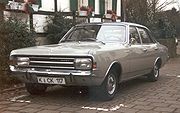 |
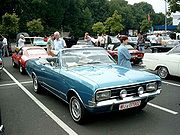 |
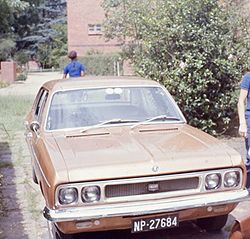 |
Opel Rekord D (1972–77)
About 1.1 million Rekord Ds were made. Because the name Rekord D was easily mistaken to connote a diesel-powered car, the name Rekord II was often used in sales literature. The first prototype was ready in 1971. The engine types available were 1897 cc, 1698 cc and 2068 cc CIH (cam-in-head) four-cylinder gasoline engines. There was also a diesel version with an engine whose displacement was initially 2.1 litres and afterwards reduced to 2.0 litres. The diesel engine was higher than gasoline variants, so diesel model hoods have a raised mid-section. The six-cylinder variant of this car is called the Commodore B. Transmissions available were standard four-speed manual with either floor or steering-column shifter and TH-180 automatic transmission. The body is of unitary construction. Body types available were four-door saloon, four-door estate and two-door coupé. There was also a variant called "Berlina" with more luxurious interior and wheels.The Rangers were also transferred to this new generation, with the dropping of the 130 and 153 and the adding of a 1.7 L engine. In 1972, the line-up consisted of the base Ranger 1700, the mid-level Ranger 1900, and the top-of-the-line Ranger 2500. In 1974, a 2.8L engine was introduced to the Ranger family. However, by that time the Rangers were unpopular, and were discontinued after the 1976 model year. Most of these were sold exclusively in Continental Europe, especially the Benelux
Benelux
The Benelux is an economic union in Western Europe comprising three neighbouring countries, Belgium, the Netherlands, and Luxembourg. These countries are located in northwestern Europe between France and Germany...
region.
South Africa used this body type for their Chevrolet 2500, 3800 and 4100 series. They looked visually almost identical but had the Chevrolet 2500 (4 cylinder) or 3800 and 4100 (6 cylinder) engines installed. They were available as four door saloon or estate. The six cylinder versions could be differentiated from the "fours" as they had four round headlights as opposed to the two rectangular units.
These cars were also assembled in Iran (before revolution) from 1974 till 1977 under the local "Chevrolet Royale / or Chevrolet Iran" brand-name by Iran General Motors
Pars Khodro
Pars Khodro is an Iranian automobile manufacturer. It was the first manufacturer of sport utility vehicles in Iran.-History:Formerly, Pars Khodro built American Motors' Rambler and General Motors products under licence. Its first cars, the Aria and the Shahin, were based on AMC's compact 1966...
. The two models were 2500 and 2800 with 2.5L and 2.8L, respectively.The production of these vehicles ended in 1977 when the assembly line started producing the Chvrolet Nova, Buick Skylark, and Cadillac Seville cars until 1987.
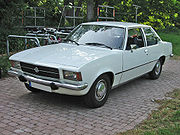 |
 |
Opel Rekord E (1977–86)
The E model can be subdivided into Rekord E1 (1977–82) and Rekord E2 (1982–86). Over 1.4 million units were made. The Rekord E was available as a two- or four-door sedan, and as a three- or five-door Caravan (station wagonStation wagon
A station wagon is a body style variant of a sedan/saloon with its roof extended rearward over a shared passenger/cargo volume with access at the back via a third or fifth door , instead of a trunk lid...
). In some markets where the tax structure was suitable, a three-door van version was also available.
A version of the EI was sold by Vauxhall
Vauxhall Motors
Vauxhall Motors is a British automotive company owned by General Motors and headquartered in Luton. It was founded in 1857 as a pump and marine engine manufacturer, began manufacturing cars in 1903 and was acquired by GM in 1925. It has been the second-largest selling car brand in the UK for...
in the United Kingdom from 1979 as the Carlton
Vauxhall Carlton
The Vauxhall Carlton was an executive car that was sold by Vauxhall in the United Kingdom from 1978 to 1994.-Mark I :The first Vauxhall Carlton was introduced in late 1978 as a replacement for the ageing VX1800/VX2000 saloons...
, which featured the distinct slanted front end shared with the Chevette
Vauxhall Chevette
The Chevette was a supermini model of car manufactured by Vauxhall in the UK from 1975 to 1984. It was Vauxhall's version of the family of small "T-Cars" from Vauxhall's parent General Motors ; the family included the Opel Kadett in Germany, the Isuzu Gemini in Japan, the Holden Gemini in...
and Cavalier
Vauxhall Cavalier
The Vauxhall Cavalier is a large family car sold primarily in the UK by Vauxhall Motors, the British division of General Motors , from 1975 to 1995...
. The Carlton quietly succeeded the (by then long since discontinued) Vauxhall Victor FE
Vauxhall Victor
The original Victor, launched on 28 February 1957, was dubbed the F series and saw a production run totalling over 390,000 units. The car was of unitary construction and featured a large glass area with heavily curved windscreen and rear window. Following then current American styling trends, the...
, and was joined by the short lived Vauxhall Viceroy, a rebadged Commodore C
Opel Commodore
The Opel Commodore is an executive car produced by Opel. It is the six-cylinder variant of the Rekord with styling differences. The Commodore nameplate was used by Opel from 1967 to 1982. However, its lineage continues with the Australian Holden Commodore...
. In the UK both models were outsold by the Ford Granada
Ford Granada (Europe)
The March 1972 released Granada succeeded the British Ford Zephyr, and the German P7-series as Ford's European executive car offering. At first, lower models in the range were called the Ford Consul, but from 1975 on they were all called Granadas. The car soon became popular for taxi, fleet and...
.
After the release of the E2 in 1982, Vauxhall Carltons were distinguishable from Opel Rekords only by their badging, with no sheet metal changes. Models sold in the UK had 2.0 L petrol and 2.3 L diesel engines in base, Berlina and Berlina S trim levels, and were all available with either a four-speed manual or a three-speed automatic transmission. In mainland Europe a host of different engines were available, ranging from a 1.7 L to a 2.2 L petrol and also including a 2.0 L diesel for countries such as Italy, where larger engines were heavily taxed. The diesel engines were taller and necessitated a distinctive bonnet with a large hump in it. Diesel Rekords were particularly popular in France, Italy, and the Benelux
Benelux
The Benelux is an economic union in Western Europe comprising three neighbouring countries, Belgium, the Netherlands, and Luxembourg. These countries are located in northwestern Europe between France and Germany...
countries.

Opel Commodore
The Opel Commodore is an executive car produced by Opel. It is the six-cylinder variant of the Rekord with styling differences. The Commodore nameplate was used by Opel from 1967 to 1982. However, its lineage continues with the Australian Holden Commodore...
) to accommodate the Holden straight-6 and V8 engines.
In South Africa the model was sold as a Chevrolet
Chevrolet
Chevrolet , also known as Chevy , is a brand of vehicle produced by General Motors Company . Founded by Louis Chevrolet and ousted GM founder William C. Durant on November 3, 1911, General Motors acquired Chevrolet in 1918...
until 1982, when it was rebadged as an Opel. South African Rekords originally received a small bore version of GM's venerable Iron Duke
GM Iron Duke engine
Iron Dukes were fitted with fuel injection in 1982. This version was christened the Tech IV, though Car and Driver later ridiculed it as the low-Tech IV. Power output remained at ....
four-cylinder engine, of 2,320 cc and 90 PS at 4,800 rpm. The facelifted EII versions received the 1,979 cc four as used in Europe, with 100 PS (110 PS for the fuel injected version). Delta Motor Corporation, which bought out GM's South African subsidiary after it divested from the country in 1986, produced the EII model until the early 1990s. Later South African Rekords featured the Opel badge above the grille, similar to the smaller Kadett.
A version of the Rekord, known as the Royale
Daewoo Royale
The Daewoo Royale is a series of mid-size cars that was produced by Daewoo Motors in South Korea from 1983, being replaced by the Daewoo Prince in 1991, although production of the top-line Daewoo Imperial continued until 1993...
, was produced by Daewoo
GM Daewoo
GM Korea Company is South Korea's second largest automobile manufacturer and is a division of the General Motors Company. GM Korea's roots go back to the former Daewoo which was split from its parent company, Daewoo Group, in 2001...
in South Korea
South Korea
The Republic of Korea , , is a sovereign state in East Asia, located on the southern portion of the Korean Peninsula. It is neighbored by the People's Republic of China to the west, Japan to the east, North Korea to the north, and the East China Sea and Republic of China to the south...
, featuring the front end of the larger Senator
Opel Senator
The Opel Senator was a large automobile, two generations of which were sold in Europe by Opel, from 1978 until 1993. A saloon, its first incarnation was also available with a fastback coupé body as the Opel Monza and Vauxhall Royale Coupe....
. This should not be confused with the Vauxhall Royale, which was effectively a rebadged Opel Monza/Opel Senator. Bodies for the Daewoo came from Holden in Australia.
UK Models

| Type | Saloon | Estate | Engine | Years Av. |
|---|---|---|---|---|
| Rekord | X | - | 2.0 | 1978–80 |
| Rekord DL | - | X | 2.0 | 1978–80 |
| Rekord Berlina, HL | X | - | 2.0 | 1978–80 |
| Rekord S | X | X | 2.0 | 1980–82 |
| Rekord Berlina S | X | - | 2.0 | 1980–82 |
| Rekord Berlina CD | X | - | 2.0 | 1978–82 |
| Rekord Diesel DL | X | X | 2.3D | 1978–80 |
| Rekord Diesel | X | X | 2.3D | 1980–82 |
External links
- http://www.opel-p1.nl/ Opel P1 websites
- Opel Rekord.
- Opel Rekord Body History.
- GM Trivia, GMInsideNews Forums.
- Classic Opel Parts database

